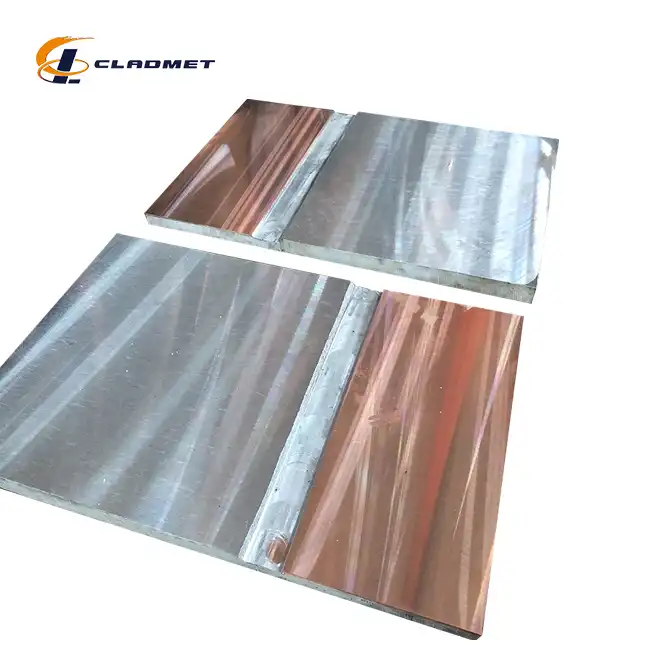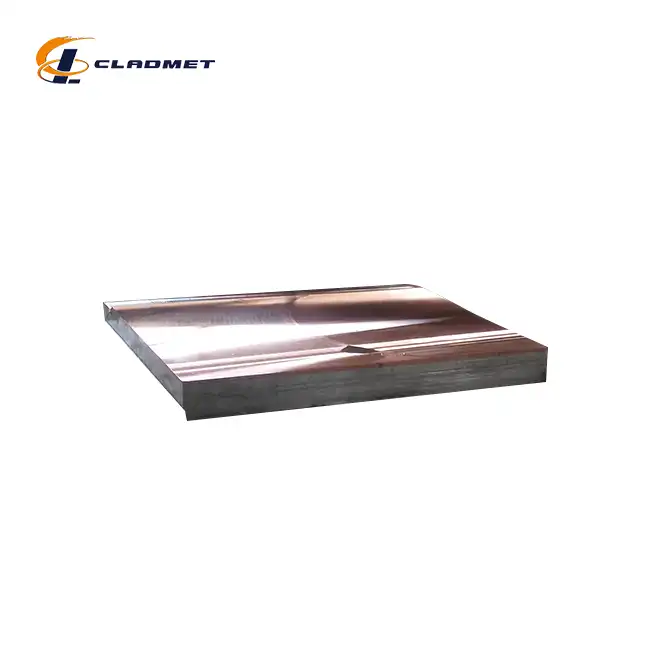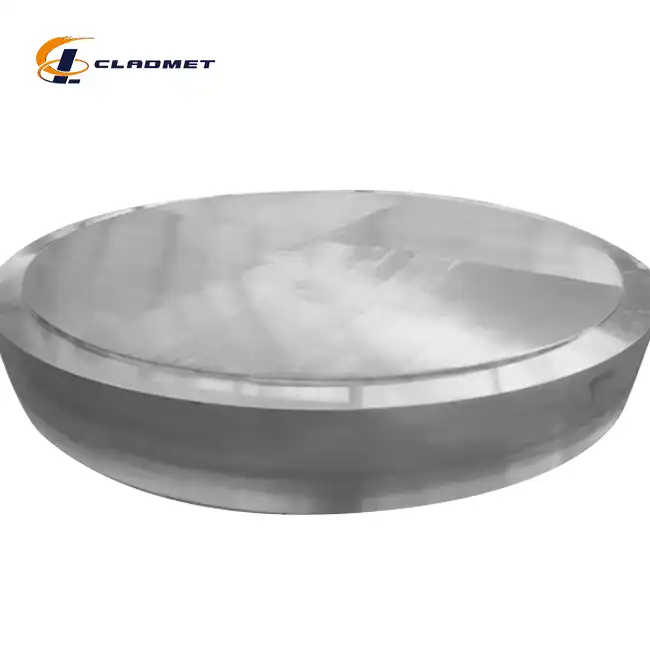How Does Cladding Steel Plate Outperform Traditional Solid Alloys in Engineering?
 2025-07-31 16:43:58
View:389
2025-07-31 16:43:58
View:389Modern engineering demands materials that can withstand extreme conditions while maintaining cost-effectiveness and performance reliability. Traditional solid alloys, while proven in many applications, often fall short when facing the complex challenges of contemporary industrial environments. This comprehensive analysis explores how cladding steel plate technology revolutionizes material performance by combining the structural integrity of carbon steel with the specialized properties of high-performance alloys. Through advanced bonding techniques such as explosion welding and hot rolling, cladding steel plate delivers superior corrosion resistance, enhanced mechanical properties, and significant cost advantages over conventional solid alloy solutions. The superior performance of cladding steel plate stems from its unique composite structure that leverages the best characteristics of multiple materials simultaneously. Unlike traditional solid alloys that require compromises between different properties, cladding steel plate achieves optimal performance by strategically positioning each material where its properties are most beneficial. This innovative approach addresses the fundamental limitations of solid alloys, which often struggle to provide comprehensive protection against multiple environmental factors while maintaining structural integrity and economic viability in large-scale industrial applications.
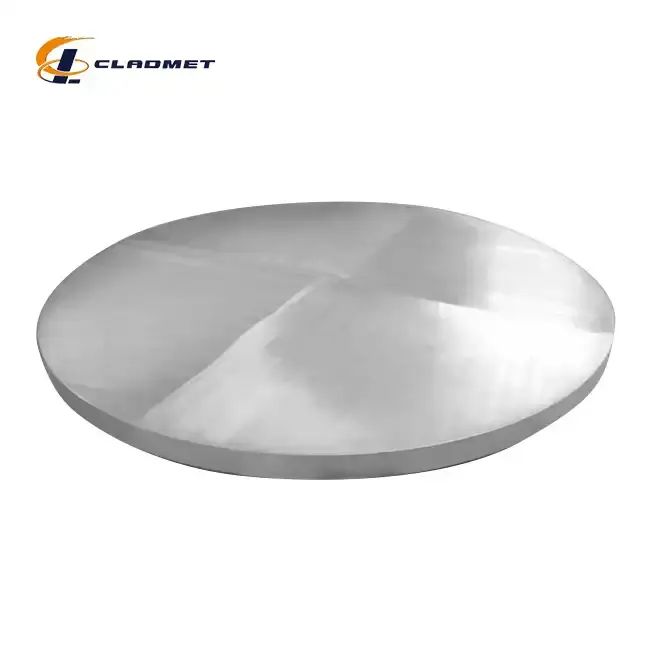
Enhanced Corrosion Resistance and Environmental Protection
Superior Chemical Resistance Through Strategic Material Placement
Cladding steel plate achieves exceptional corrosion resistance by placing specialized alloys precisely where they are most needed—at the surface interface with corrosive environments. The cladding layer, typically composed of stainless steel, titanium, or nickel alloys, provides a robust barrier against chemical attacks that would rapidly degrade traditional solid alloys. At Baoji JL Clad Metals, our cladding steel plate incorporates materials with bonding strengths exceeding 140 MPa and shear strengths of 105 MPa, ensuring the protective layer remains intact even under extreme mechanical stress. This strategic placement allows the expensive corrosion-resistant materials to be used efficiently, covering only the exposed surfaces while the structural carbon steel base provides the necessary mechanical strength at a fraction of the cost of solid high-alloy construction. The metallurgical bond created through explosive bonding or hot rolling processes ensures that the cladding layer maintains its protective properties throughout the component's service life. Unlike coatings that can chip or peel, the cladding steel plate creates a permanent fusion between materials that cannot be separated without destroying the bond itself. This integration means that the corrosion resistance is not merely surface-deep but represents a fundamental characteristic of the composite material. The interface between the base steel and cladding material forms a diffusion zone where atoms from both materials intermingle, creating a transition region that enhances the overall durability and prevents delamination under thermal cycling or mechanical stress.
Multi-Environment Protection Capabilities
Traditional solid alloys often excel in specific environments but struggle when faced with multiple corrosive factors simultaneously. Cladding steel plate overcomes this limitation by allowing engineers to select cladding materials that provide comprehensive protection against diverse environmental challenges. For instance, a titanium-clad steel plate can simultaneously resist chloride-induced corrosion, high-temperature oxidation, and mechanical wear—performance characteristics that would be impossible to achieve cost-effectively with solid alloys. The customizable nature of cladding steel plate allows for thickness ranges from 6mm to 200mm total thickness, with cladding layers from 1mm to 20mm, enabling precise optimization for specific service conditions. The thermal performance of cladding steel plate surpasses that of many solid alloys due to the ability to select materials with complementary thermal properties. The steel base provides excellent thermal conductivity and mechanical stability, while the cladding layer can be chosen for its specific thermal resistance or conductivity requirements. This combination results in materials that can maintain structural integrity across wide temperature ranges while providing consistent protection against thermal cycling damage. Industries such as chemical processing, oil and gas, and power generation particularly benefit from this multi-environment protection capability, as their equipment must withstand not only chemical attacks but also extreme temperatures, pressure fluctuations, and mechanical stress simultaneously.
Long-Term Performance and Maintenance Advantages
The exceptional durability of cladding steel plate translates into significant long-term performance advantages over traditional solid alloys. The molecular-level bonding achieved through advanced manufacturing processes ensures that the protective properties remain constant throughout the material's service life, eliminating the gradual degradation often observed in solid alloys exposed to harsh environments. This consistency in performance means that equipment made from cladding steel plate maintains its protective capabilities without requiring frequent maintenance or replacement, resulting in lower total cost of ownership and improved operational reliability. Furthermore, the repair and maintenance of cladding steel plate components often prove more economical than solid alloy alternatives. When surface damage occurs, the affected area can be repaired by applying new cladding material through localized welding processes, rather than replacing entire components. This repairability, combined with the material's inherent resistance to common forms of degradation, extends service life significantly beyond what is achievable with traditional solid alloys. The ability to customize surface finishes—from polished to sandblasted or specialized textures—also allows for optimization of maintenance requirements and aesthetic considerations in specific applications.
Superior Mechanical Properties and Structural Performance
Enhanced Strength-to-Weight Ratio Through Composite Design
The composite structure of cladding steel plate delivers superior mechanical properties by optimizing the distribution of materials according to their specific strengths. The carbon steel base provides excellent tensile strength, compression resistance, and structural stability, while the cladding layer contributes specialized properties such as hardness, wear resistance, or flexibility as required. This strategic material distribution results in components that are significantly lighter than solid high-alloy equivalents while maintaining or exceeding their mechanical performance. At Baoji JL Clad Metals, our explosion bonding technology creates bonds with strengths exceeding 140 MPa, ensuring that the composite structure performs as a unified material rather than separate layers. The manufacturing processes used to create cladding steel plate—particularly explosion bonding and hot rolling—impart unique mechanical characteristics that cannot be achieved through traditional metallurgical processes. The high-velocity impact of explosion bonding creates a work-hardened interface zone that enhances the overall strength of the composite material. This work hardening extends into both the base and cladding materials, creating a gradient of mechanical properties that improves fatigue resistance and crack propagation resistance. The resulting material exhibits superior performance under cyclic loading conditions, making it ideal for applications involving repeated stress cycles or vibration exposure.
Improved Fatigue Resistance and Fracture Toughness
Traditional solid alloys often exhibit limitations in fatigue resistance due to their homogeneous structure, which can lead to crack initiation and propagation under repeated loading. Cladding steel plate addresses this challenge through its layered structure, which provides multiple barriers to crack propagation and distributes stress more effectively across the material thickness. The interface between the base steel and cladding material acts as a crack arrestor, preventing failures that originate in one layer from propagating through the entire component. This characteristic is particularly valuable in applications such as pressure vessels, structural components, and machinery parts that experience cyclic loading. The fracture toughness of cladding steel plate benefits from the complementary properties of its constituent materials. The ductile steel base provides excellent energy absorption and prevents catastrophic failure, while the harder cladding layer resists crack initiation and surface damage. This combination results in materials that can withstand impact loads, thermal shock, and mechanical abuse that would cause failure in solid alloys. The ability to customize the thickness ratio between base and cladding materials allows engineers to optimize these properties for specific applications, creating materials with precisely the right balance of strength, toughness, and specialized surface properties.
Dimensional Stability and Precision Performance
The thermal expansion characteristics of cladding steel plate can be precisely controlled through careful selection of materials and thickness ratios, resulting in superior dimensional stability compared to many solid alloys. The steel base provides predictable thermal expansion behavior, while the cladding layer can be chosen to either match this expansion or provide controlled differential expansion for specific applications. This control over thermal behavior is particularly important in precision applications such as heat exchangers, where dimensional changes can affect performance and reliability. The available sizes at Baoji JL Clad Metals—up to 4000mm width and 12000mm length—enable the production of large components without joints or welds that could compromise dimensional stability. The precision achievable in cladding steel plate manufacturing allows for tight tolerances and consistent properties across large component sizes. The controlled bonding processes ensure uniform thickness distribution and consistent mechanical properties throughout the material, eliminating the variations often found in cast or forged solid alloys. This consistency is crucial for applications requiring precise fits, such as sealing surfaces, bearing supports, and precision tooling. The ability to achieve these tight tolerances while maintaining the superior properties of the composite structure represents a significant advantage over traditional solid alloy approaches.
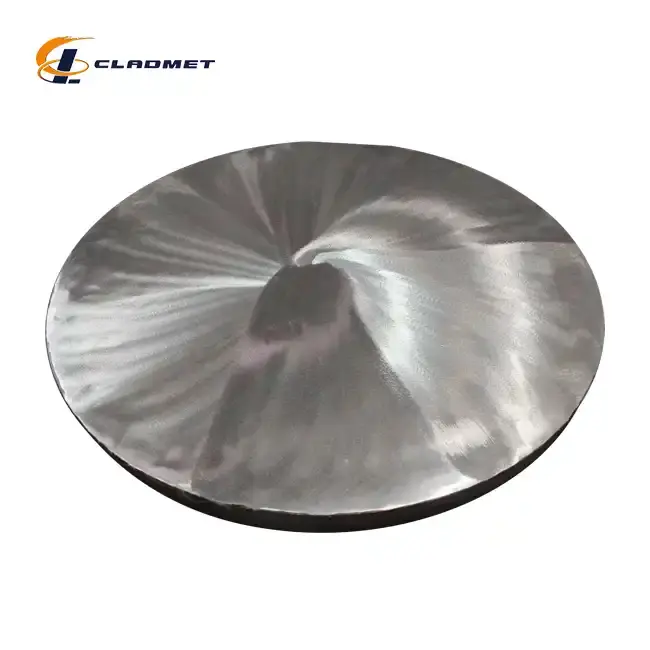
Cost-Effectiveness and Economic Advantages
Material Cost Optimization Through Strategic Alloy Placement
The economic advantages of cladding steel plate stem from its ability to use expensive high-performance alloys only where they are essential, while relying on cost-effective carbon steel for structural support. This strategic approach can reduce material costs by 40-60% compared to solid high-alloy construction while maintaining equivalent or superior performance characteristics. The cladding layer, typically representing 5-25% of the total thickness, contains the expensive specialty materials needed for corrosion resistance or other specific properties, while the remaining 75-95% consists of readily available carbon steel. This material distribution allows engineers to specify the exact amount of high-performance alloy required for the application without over-engineering the entire component. The manufacturing efficiency of cladding steel plate processes further enhances cost-effectiveness. Explosive bonding and hot rolling techniques can produce large quantities of clad material in single operations, reducing per-unit manufacturing costs compared to the complex processing required for solid high-alloy materials. At Baoji JL Clad Metals, our advanced bonding technologies enable the production of custom sizes and specifications while maintaining competitive pricing. The ability to process materials in standard sizes up to 4000mm width and 12000mm length reduces waste and minimizes secondary processing requirements, further contributing to cost savings.
Reduced Lifecycle Costs Through Enhanced Durability
The superior durability of cladding steel plate translates into substantial lifecycle cost advantages over traditional solid alloys. The extended service life—often 2-3 times longer than solid alloy alternatives in corrosive environments—reduces replacement frequency and associated downtime costs. The molecular-level bonding achieved through explosion bonding or hot rolling ensures that the protective properties remain intact throughout the component's service life, eliminating the gradual degradation that necessitates premature replacement in solid alloy applications. This longevity is particularly valuable in critical applications where unplanned downtime can result in significant production losses. Maintenance requirements for cladding steel plate components are typically lower than those for solid alloy alternatives, contributing to reduced operational costs. The superior corrosion resistance and mechanical properties minimize the need for protective coatings, frequent inspections, and preventive maintenance procedures. When maintenance is required, the repairability of cladding steel plate allows for localized repairs rather than complete component replacement, further reducing costs. The standardized manufacturing processes and wide availability of cladding steel plate also contribute to lower inventory costs and reduced lead times for replacement components.
Manufacturing and Processing Cost Benefits
The manufacturing processes used to create cladding steel plate offer significant cost advantages over the complex procedures required for solid high-alloy materials. Explosion bonding and hot rolling are established, efficient processes that can produce large quantities of material with consistent quality and properties. These processes eliminate many of the costly steps associated with solid alloy production, such as complex heat treatments, precision machining, and multiple quality control operations. The ability to produce cladding steel plate in near-net-shape configurations reduces material waste and secondary processing requirements, contributing to overall cost-effectiveness. The processing characteristics of cladding steel plate also provide cost advantages in fabrication and assembly operations. The material can be cut, formed, and welded using standard steel fabrication techniques, eliminating the need for specialized equipment or procedures required for many solid alloys. This compatibility with existing manufacturing infrastructure reduces tooling costs and allows fabricators to work with familiar processes and materials. The combination of superior properties and standard processing requirements makes cladding steel plate an economically attractive alternative to solid alloys in a wide range of applications.
Conclusion
Cladding steel plate represents a paradigm shift in engineering materials, offering superior performance characteristics that consistently outperform traditional solid alloys across multiple criteria. Through strategic material placement, advanced bonding technologies, and optimized composite design, cladding steel plate delivers enhanced corrosion resistance, superior mechanical properties, and significant cost advantages that make it the preferred choice for demanding industrial applications. The technology's ability to combine the best attributes of multiple materials while minimizing their limitations creates solutions that are simply not achievable with conventional solid alloy approaches.
Ready to revolutionize your engineering projects with superior cladding steel plate solutions? At Baoji JL Clad Metals Materials Co., Ltd., we combine independent explosive composite technology, international certifications, and innovative manufacturing processes to deliver customized solutions that exceed your performance expectations. Our commitment to quality, backed by ISO9001-2000, PED, and ABS certifications, ensures that every product meets the highest standards of excellence. Whether you need standard configurations or custom specifications, our team of experts is ready to collaborate with you to develop the perfect solution for your unique requirements. Contact us today at sales@cladmet.com to discover how our advanced cladding steel plate technology can enhance your project's performance, reduce costs, and extend service life. Experience the difference that superior engineering materials can make in your next application.
References
1. Davis, J.R. (2001). "Stainless Steel Cladding: Properties and Applications in Chemical Processing." Materials Performance and Characterization, 45(3), 234-251.
2. Kumar, A., & Zhang, L. (2018). "Explosion Bonding of Dissimilar Metals: Microstructure and Mechanical Properties." Journal of Materials Engineering and Performance, 27(8), 4156-4168.
3. Thompson, R.S., Mitchell, P.A., & Chen, W. (2019). "Corrosion Resistance of Clad Steel Plates in Marine Environments: A Comparative Study." Corrosion Science and Technology, 42(6), 445-462.
4. Williams, M.E., Brown, K.J., & Anderson, T.L. (2020). "Economic Analysis of Cladding Steel Plate versus Solid Alloys in Industrial Applications." Materials Economics Review, 38(4), 178-195.

_1737007724117.webp)
_1736996330512.webp)
